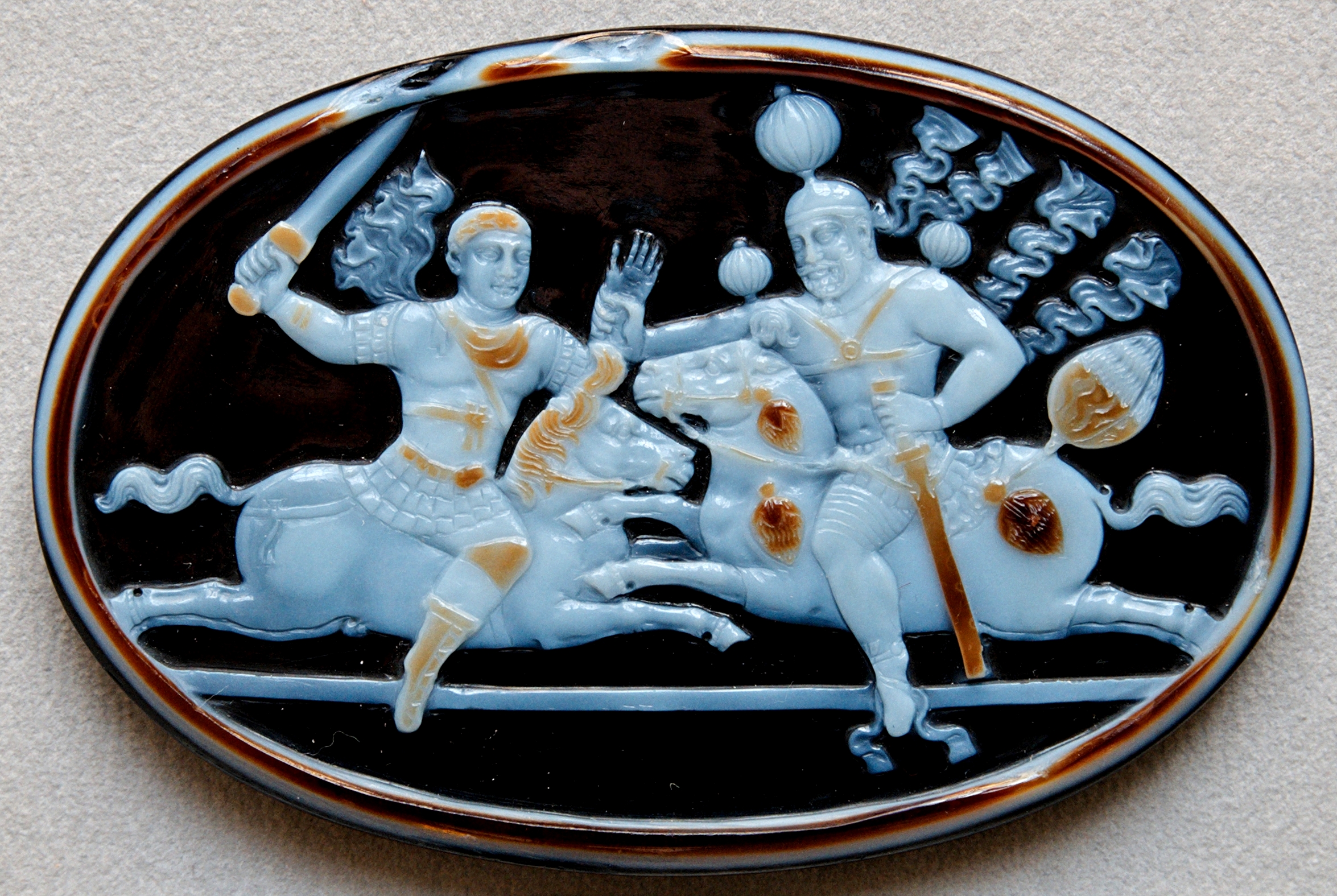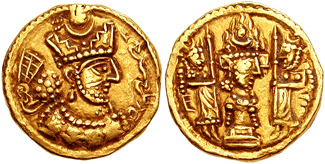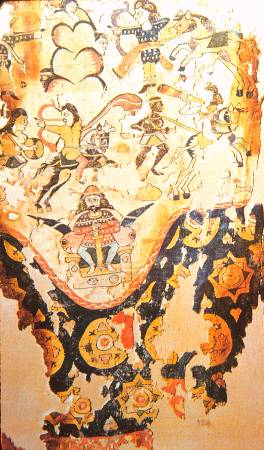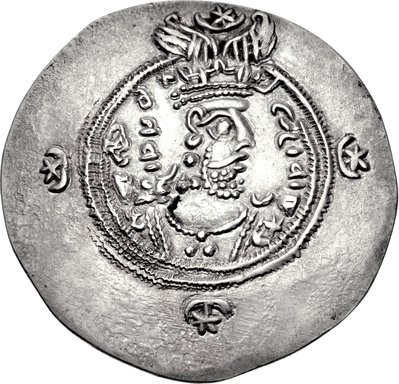Timeline of Sasanian Empire on:
[Wikipedia]
[Google]
[Amazon]
 The
The 
 * 224 -
* 224 -  * 276 - The
* 276 - The  * c. 294 - Narseh’s
* c. 294 - Narseh’s 409 - Christian are permitted to publicly worship and to build churches
thenagain.info * 420 - Coronation of Bahram V (Bahram Gūr).
* 421 - Peace between Persia and Rome comes to an end.
* 422 - Bahram V triumphs in driving off an assault by the
* 420 - Coronation of Bahram V (Bahram Gūr).
* 421 - Peace between Persia and Rome comes to an end.
* 422 - Bahram V triumphs in driving off an assault by the  * 531 - Coronation of
* 531 - Coronation of  * c. 570 - Conquest of Yemen.
* 579 - Death of
* c. 570 - Conquest of Yemen.
* 579 - Death of  * 632 - '' Pond of Khumm event.''
* 632 - ''The Prophet Moḥammad dies; there ensues a dispute over his succession.''
* 632-634 - '' Abu Bakr’s caliphate.''
* 633 - Yazdegerd III succeeds to the Persian throne.
* 634 - '' Umar elected caliph; he plans a successful invasion of Byzantine and Persian (Sasanian) lands.''
* 635 - ''Arabs capture
* 632 - '' Pond of Khumm event.''
* 632 - ''The Prophet Moḥammad dies; there ensues a dispute over his succession.''
* 632-634 - '' Abu Bakr’s caliphate.''
* 633 - Yazdegerd III succeeds to the Persian throne.
* 634 - '' Umar elected caliph; he plans a successful invasion of Byzantine and Persian (Sasanian) lands.''
* 635 - ''Arabs capture
CHRONOLOGY OF IRANIAN HISTORY PART 1
''iranicaonline.org'' 1 November 2015 {{Sasanian Empire Ancient timelines Sasanian Empire
 The
The Sassanid Empire
The Sasanian () or Sassanid Empire, officially known as the Empire of Iranians (, ) and also referred to by historians as the Neo-Persian Empire, was the last Iranian empire before the early Muslim conquests of the 7th-8th centuries AD. Named ...
or Sassanian Dynasty is the name used for the Persian dynasty which lasted from 224 to 651 AD.

 * 224 -
* 224 - Ardashir I
Ardashir I (Middle Persian: 𐭠𐭥𐭲𐭧𐭱𐭲𐭥, Modern Persian: , '), also known as Ardashir the Unifier (180–242 AD), was the founder of the Sasanian Empire. He was also Ardashir V of the Kings of Persis, until he founded the new emp ...
introduces the title Šāhanšāh (king of kings); the Sasanid reign is founded.
* c. 224-240 – Zoroastrianism belief experiences an era of recovery under the reign of Ardashir I.
* 230 - The Sassanian army assaults the Roman-controlled fraction of Upper Mesopotamia and lay hands on Nisibis, but fails to catch it.
* 237-238 - Ardashir I begins another rushes on the Eastern Roman Provinces and occupies Harran and Nisibis.
* 241 - Coronation of Shapur I.
* c. 242-273 - Mani
Mani may refer to:
Geography
* Maní, Casanare, a town and municipality in Casanare Department, Colombia
* Mani, Chad, a town and sub-prefecture in Chad
* Mani, Evros, a village in northeastern Greece
* Mani, Karnataka, a village in Dakshi ...
makes a journey in Persia.
* 252-256 - Shapur I moves forward to the Eastern Roman Provinces.
* c. 259 - Defeat and capture of Valerian by Shapur I.
* c. 260 - 2nd foray of the Eastern Roman Provinces by Shapur I.
* c. 261 - Odaenathus, the ruler of Palmyra, stops the triumphant Persian troops coming back home following the looting of Antioch, scores a notable conquest against Shapur I and drives the Persians back across the Euphrates
The Euphrates () is the longest and one of the most historically important rivers of Western Asia. Tigris–Euphrates river system, Together with the Tigris, it is one of the two defining rivers of Mesopotamia ( ''the land between the rivers'') ...
.
* 271 - Coronation of Hormizd I.
* 273 - Coronation of Bahram I
Bahram I (also spelled Wahram I or Warahran I; pal, 𐭥𐭫𐭧𐭫𐭠𐭭) was the fourth Sasanian King of Kings of Iran from 271 to 274. He was the eldest son of Shapur I () and succeeded his brother Hormizd I (), who had reigned for a year ...
.
* 274 or 277 - The execution of Mani
Mani may refer to:
Geography
* Maní, Casanare, a town and municipality in Casanare Department, Colombia
* Mani, Chad, a town and sub-prefecture in Chad
* Mani, Evros, a village in northeastern Greece
* Mani, Karnataka, a village in Dakshi ...
by influential Zoroastrian high priest Kartir
Kartir (also spelled Karder, Karter and Kerdir; Middle Persian: 𐭪𐭫𐭲𐭩𐭫 ''Kardīr'') was a powerful and influential Zoroastrian priest during the reigns of four Sasanian kings in the 3rd-century. His name is cited in the inscriptions ...
.
* 276 - Coronation of Bahram II
Bahram II (also spelled Wahram II or Warahran II; pal, 𐭥𐭫𐭧𐭫𐭠𐭭) was the fifth Sasanian King of Kings (''shahanshah'') of Iran, from 274 to 293. He was the son and successor of Bahram I (). Bahram II, while still in his teens, ...
.
 * 276 - The
* 276 - The Kartir
Kartir (also spelled Karder, Karter and Kerdir; Middle Persian: 𐭪𐭫𐭲𐭩𐭫 ''Kardīr'') was a powerful and influential Zoroastrian priest during the reigns of four Sasanian kings in the 3rd-century. His name is cited in the inscriptions ...
is chosen as extreme power of the Zoroastrian place of worship and victimizes the supporters of other believes; his engravings at Ka'ba-ye Zartosht, Naqsh-e Rajab
Naqsh-e Rajab ( fa, نقش رجب, ) is an archaeological site just west of Istakhr and about 5 km north of Persepolis in Fars Province, Iran.
Together with Naqsh-e Rustam, which lies 2.5 km away, the site is part of the Marvdasht ...
, and Sar Mashhad
Sar Mashhad ( fa, سرمشهد; also known as Sar Meshad) is a village in Dadin Rural District, Jereh and Baladeh District, Kazerun County, Fars Province, Iran. At the 2012 census, its population was 3,047, in 623 families.
The place is notable ...
(south of Kazerun) declare to prove his principles.
* 283 - Roman Emperor Carus
Marcus Aurelius Carus (c. 222 – July or August 283) was Roman emperor from 282 to 283. During his short reign, Carus fought the Germanic tribes and Sarmatians along the Danube frontier with success.
He died while campaigning against th ...
seizes Mesopotamia and catches Ctesiphon
Ctesiphon ( ; Middle Persian: 𐭲𐭩𐭮𐭯𐭥𐭭 ''tyspwn'' or ''tysfwn''; fa, تیسفون; grc-gre, Κτησιφῶν, ; syr, ܩܛܝܣܦܘܢThomas A. Carlson et al., “Ctesiphon — ܩܛܝܣܦܘܢ ” in The Syriac Gazetteer last modi ...
, but his troops comes back his unexpected passing.
* 286 - Tiridates takes the Armenian throne and the Persians are discharged from there.
* 293 - Narseh overwhelms his competitors and triumphs to the Persian throne.
Paikuli inscription
The Paikuli inscription ( ku, پەیکوڵی, Peykulî, fa, پایکولی, in ar, بيكولي) is a bilingual Parthian and Middle Persian text corpus which was inscribed on the stone blocks of the walls of Paikuli tower; the latter is located ...
in Iraq next to the Persian frontier.
* 296 - Narseh raids Armenia, expels Tiridates, and quells the Romans.
* 297- Roman Emperor Galerius undoes Narseh. The Treaty of Nisibis compels Narseh to abandon Armenia and Mesopotamia.
* c. 301 - The realm of Armenia is the first nation to accept Christianity as the state religion.
* 302 - Resignation of Narseh; Coronation of Hormizd II.
* 309 - Coronation of Shapur II.
* 325 - Shapur II falls upon Arab people and makes impregnable the empire’s frontiers.
* 338 - Shapur II retrieves the five regions gave in by Narseh to Rome.
* 348 - Shapur II seizes Mesopotamia.
* c. 360 - Fondation of the Kidarite kingdom
The Kidarites, or Kidara Huns, were a dynasty that ruled Bactria and adjoining parts of Central Asia and South Asia in the 4th and 5th centuries. The Kidarites belonged to a complex of peoples known collectively in India as the Huna people, Huna, ...
.
* 363 - War between Julian
Julian may refer to:
People
* Julian (emperor) (331–363), Roman emperor from 361 to 363
* Julian (Rome), referring to the Roman gens Julia, with imperial dynasty offshoots
* Saint Julian (disambiguation), several Christian saints
* Julian (give ...
and Persian troops follows his back off and demise; the surrendered territories and Nisibis are brought back to Persia.
* 376 - The armistice signed by Rome and Persia.
* 379 - Death of Shapur II and the accession of Ardashir II
Ardashir II ( pal, 𐭠𐭥𐭲𐭧𐭱𐭲𐭥, Ardašīr), was the Sasanian King of Kings () of Iran from 379 to 383. He was the brother of his predecessor, Shapur II (), under whom he had served as vassal king of Adiabene, where he fought along ...
.
* 383 - Coronation of Shapur III.
* 399 - Coronation of Yazdegerd I, titled “the Sinner” owing to his efforts to control the influence of Zoroastrian clergy and his leniency towards other believes.
* 409 - Christian are allowed to publicly worship and to construct churches.thenagain.info
 * 420 - Coronation of Bahram V (Bahram Gūr).
* 421 - Peace between Persia and Rome comes to an end.
* 422 - Bahram V triumphs in driving off an assault by the
* 420 - Coronation of Bahram V (Bahram Gūr).
* 421 - Peace between Persia and Rome comes to an end.
* 422 - Bahram V triumphs in driving off an assault by the Hephtalites
The Hephthalites ( xbc, ηβοδαλο, translit= Ebodalo), sometimes called the White Huns (also known as the White Hunas, in Iranian languages, Iranian as the ''Spet Xyon'' and in Sanskrit as the ''Sveta-huna''), were a people who lived in Cen ...
.
* c. 425 - Bahram V brings in gypsies from India to amuse people according to the Shahnameh.
* 428 - Dissolution of Arsacid dynasty of Armenia. Establishment of Persian Armenia
Sasanian Armenia, also known as Persian Armenia and Persarmenia ( hy, Պարսկահայաստան – ''Parskahayastan''), may either refer to the periods in which Armenia ( pal, 𐭠𐭫𐭬𐭭𐭩 – ''Armin'') was under the suzerainty of ...
.
* 438 - Coronation of Yazdegerd II
Yazdegerd II (also spelled Yazdgerd and Yazdgird; pal, 𐭩𐭦𐭣𐭪𐭥𐭲𐭩), was the Sasanian King of Kings () of Iran from 438 to 457. He was the successor and son of Bahram V ().
His reign was marked by wars against the Eastern Roman ...
.
* 451 - Battle of Avarayr fought against the Christian Armenian rebels led by Vardan Mamikonian.
* 457 - Coronation of Hormizd III.
* 459 - Coronation of Peroz I.
* 484 - Hephthalite Empire
The Hephthalites ( xbc, ηβοδαλο, translit= Ebodalo), sometimes called the White Huns (also known as the White Hunas, in Iranian as the ''Spet Xyon'' and in Sanskrit as the ''Sveta-huna''), were a people who lived in Central Asia during th ...
conquer Peroz I.
* 484 - Coronation of Balash
Balash (Middle Persian: 𐭥𐭥𐭣𐭠𐭧𐭱𐭩, ) was the Sasanian King of Kings of Iran from 484 to 488. He was the brother and successor of Peroz I (), who had been defeated and killed by a Hephthalite army.
Name
''Balāsh'' () is the N ...
. The Nvarsak Treaty
The Treaty of Nvarsak (also spelled Nuarsak) was signed between the Armenian rebel leader Vahan Mamikonian and the representatives of the Sasanian King of Kings (''shahanshah'') Balash () at Nvarsak in 484.
Overview
The Nvarsak Treaty was concl ...
grants the Armenians the right to profess Christianity freely.
* 488 - Coronation of Kavadh I; expedition against Khazars.
* c. 490 - Mazdak teaches his egalitarian ideology with the benefit of Kavadh I’s support.
* c. 490 - Initiation of agrarian and tax reforms.
* 496 - Kavadh I is dethroned by his brother Djamasp.
* 499 - Return of Kavadh I with support of Hephtalites
The Hephthalites ( xbc, ηβοδαλο, translit= Ebodalo), sometimes called the White Huns (also known as the White Hunas, in Iranian languages, Iranian as the ''Spet Xyon'' and in Sanskrit as the ''Sveta-huna''), were a people who lived in Cen ...
.
* 524 - War between Byzantine Empire and Sassanid Empire
The Sasanian () or Sassanid Empire, officially known as the Empire of Iranians (, ) and also referred to by historians as the Neo-Persian Empire, was the last Iranian empire before the early Muslim conquests of the 7th-8th centuries AD. Named ...
.
* 526 - Romans assault Persia, Armenia, and Mesopotamia, however they are beaten. Start of the Iberian War.
 * 531 - Coronation of
* 531 - Coronation of Khosrow I
Khosrow I (also spelled Khosrau, Khusro or Chosroes; pal, 𐭧𐭥𐭮𐭫𐭥𐭣𐭩; New Persian: []), traditionally known by his epithet of Anushirvan ( [] "the Immortal Soul"), was the Sasanian Empire, Sasanian King of Kings of Iran from ...
.
* c. 531 - Slaughter and crackdown of the Mazdak's followers.
* c. 531 - Farming, governmental, military, communal reforms.
* c. 531 - Conversion of Panchatantra
The ''Panchatantra'' (IAST: Pañcatantra, ISO: Pañcatantra, sa, पञ्चतन्त्र, "Five Treatises") is an ancient Indian collection of interrelated animal fables in Sanskrit verse and prose, arranged within a frame story.
, a Sanskrit-written book-story to Middle Persian.
* 533 - End of conflict between Persia and Byzantine Empire (the one that started in 524).
* 541 - Lazic War commences between the Byzantines and the Sassanids for control over Lazica.
* c. 554 - Procopius, Byzantine expert and observer to the battles between Khosrow I
Khosrow I (also spelled Khosrau, Khusro or Chosroes; pal, 𐭧𐭥𐭮𐭫𐭥𐭣𐭩; New Persian: []), traditionally known by his epithet of Anushirvan ( [] "the Immortal Soul"), was the Sasanian Empire, Sasanian King of Kings of Iran from ...
and Justinian I, which he writes in his De bello Persico (Latin tr., 1833), dies.
 * c. 570 - Conquest of Yemen.
* 579 - Death of
* c. 570 - Conquest of Yemen.
* 579 - Death of Khosrow I
Khosrow I (also spelled Khosrau, Khusro or Chosroes; pal, 𐭧𐭥𐭮𐭫𐭥𐭣𐭩; New Persian: []), traditionally known by his epithet of Anushirvan ( [] "the Immortal Soul"), was the Sasanian Empire, Sasanian King of Kings of Iran from ...
and the Coronation of Hormizd IV.
* 580 - Sassanids abolish the monarchy of the Kingdom of Iberia
In Greco-Roman geography, Iberia (Ancient Greek: ''Iberia''; la, Hiberia) was an exonym for the Georgians, Georgian kingdom of Kartli ( ka, ქართლი), known after its Kartli, core province, which during Classical Antiquity and the E ...
. Direct control through self-appointed governors commences.
* 588 - First Perso-Turkic War
The First Perso-Turkic War was fought during 588–589 between the Sasanian Empire and Hephthalite principalities and its lord the Göktürks. The conflict started with the invasion of the Sasanian Empire by the Turks and ended with a decisive S ...
(with Göktürks
The Göktürks, Celestial Turks or Blue Turks ( otk, 𐱅𐰇𐰼𐰰:𐰉𐰆𐰑𐰣, Türük Bodun; ; ) were a nomadic confederation of Turkic peoples in medieval Inner Asia. The Göktürks, under the leadership of Bumin Qaghan (d. 552) and ...
) and their defeat at the hands of the Persian General Bahrām Chobin.
* 590 - Hormizd IV is assassinated; Coronation of Khosrow II
Khosrow II (spelled Chosroes II in classical sources; pal, 𐭧𐭥𐭮𐭫𐭥𐭣𐭩, Husrō), also known as Khosrow Parviz (New Persian: , "Khosrow the Victorious"), is considered to be the last great Sasanian king (shah) of Iran, ruling fr ...
.
* 590 - Uprising of Bahrām Chobin and his seizure of the Persian throne.
* 591 - Overwhelming of Bahrām Chobin; he escapes to the Turks in Central Asia but is killed after a year. Khosrow II
Khosrow II (spelled Chosroes II in classical sources; pal, 𐭧𐭥𐭮𐭫𐭥𐭣𐭩, Husrō), also known as Khosrow Parviz (New Persian: , "Khosrow the Victorious"), is considered to be the last great Sasanian king (shah) of Iran, ruling fr ...
regains the throne with the help of the Byzantine Emperor Maurice
Maurice ( la, Mauricius or ''Mauritius''; ; 539 – 27 November 602) was Eastern Roman emperor from 582 to 602 and the last member of the Justinian dynasty. A successful general, Maurice was chosen as heir and son-in-law by his predecessor Tib ...
.
* 602 - Mutiny against the Emperor Maurice
Maurice ( la, Mauricius or ''Mauritius''; ; 539 – 27 November 602) was Eastern Roman emperor from 582 to 602 and the last member of the Justinian dynasty. A successful general, Maurice was chosen as heir and son-in-law by his predecessor Tib ...
led by Phocas
Phocas ( la, Focas; grc-gre, Φωκάς, Phōkás; 5475 October 610) was Eastern Roman emperor from 602 to 610. Initially, a middle-ranking officer in the Eastern Roman army, Phocas rose to prominence as a spokesman for dissatisfied soldiers ...
. Climactic Byzantine–Sasanian War of 602–628
The Byzantine–Sasanian War of 602–628 was the final and most devastating of the Byzantine–Sasanian wars, series of wars fought between the Byzantine Empire, Byzantine / Roman Empire and the Sasanian Empire of Iran. The Byzantine–Sasani ...
commences.
* 603 - Khosrow II
Khosrow II (spelled Chosroes II in classical sources; pal, 𐭧𐭥𐭮𐭫𐭥𐭣𐭩, Husrō), also known as Khosrow Parviz (New Persian: , "Khosrow the Victorious"), is considered to be the last great Sasanian king (shah) of Iran, ruling fr ...
’s invasion of Byzantium
Byzantium () or Byzantion ( grc, Βυζάντιον) was an ancient Greek city in classical antiquity that became known as Constantinople in late antiquity and Istanbul today. The Greek name ''Byzantion'' and its Latinization ''Byzantium'' cont ...
in revenge for the murder of Emperor Maurice
Maurice ( la, Mauricius or ''Mauritius''; ; 539 – 27 November 602) was Eastern Roman emperor from 582 to 602 and the last member of the Justinian dynasty. A successful general, Maurice was chosen as heir and son-in-law by his predecessor Tib ...
and his relatives by the tyrant Phocas
Phocas ( la, Focas; grc-gre, Φωκάς, Phōkás; 5475 October 610) was Eastern Roman emperor from 602 to 610. Initially, a middle-ranking officer in the Eastern Roman army, Phocas rose to prominence as a spokesman for dissatisfied soldiers ...
.
* 611-616 - Khosrow II’s conquest of Syria and Egypt.
*614 - Khosrow II takes Jerusalem; relics of the True Cross are carried off to Ctesiphon
Ctesiphon ( ; Middle Persian: 𐭲𐭩𐭮𐭯𐭥𐭭 ''tyspwn'' or ''tysfwn''; fa, تیسفون; grc-gre, Κτησιφῶν, ; syr, ܩܛܝܣܦܘܢThomas A. Carlson et al., “Ctesiphon — ܩܛܝܣܦܘܢ ” in The Syriac Gazetteer last modi ...
, capital of the Sasanian empire.
* 622 - Heraclius mounts a counter-offensive against the Sasanians.
* 626 - The Sassanids alongside the allied Avars and Slavs
Slavs are the largest European ethnolinguistic group. They speak the various Slavic languages, belonging to the larger Balto-Slavic branch of the Indo-European languages. Slavs are geographically distributed throughout northern Eurasia, main ...
besiege the Byzantine capital, Constantinople
* 627 - Heraclius
Heraclius ( grc-gre, Ἡράκλειος, Hērákleios; c. 575 – 11 February 641), was List of Byzantine emperors, Eastern Roman emperor from 610 to 641. His rise to power began in 608, when he and his father, Heraclius the Elder, the Exa ...
defeats the troops of the Sasanian Empire near Nineveh
Nineveh (; akk, ; Biblical Hebrew: '; ar, نَيْنَوَىٰ '; syr, ܢܝܼܢܘܹܐ, Nīnwē) was an ancient Assyrian city of Upper Mesopotamia, located in the modern-day city of Mosul in northern Iraq. It is located on the eastern ban ...
.
* 628 - Deposition, trial, and execution of Khosrow II
Khosrow II (spelled Chosroes II in classical sources; pal, 𐭧𐭥𐭮𐭫𐭥𐭣𐭩, Husrō), also known as Khosrow Parviz (New Persian: , "Khosrow the Victorious"), is considered to be the last great Sasanian king (shah) of Iran, ruling fr ...
by his son and successor Kavadh II (Shīrūya); peace concluded with Byzantine Empire.
* 628 - Murdering of many Sasanian princes by Kavadh II.
* 628 - Kavadh II dies.
* 628-635 - Weakening of the Sasanian dynasty due to a succession of ineffectual kings and queens including the queens Boran and Azarmidokht; chaotic situation prevails.
 * 632 - '' Pond of Khumm event.''
* 632 - ''The Prophet Moḥammad dies; there ensues a dispute over his succession.''
* 632-634 - '' Abu Bakr’s caliphate.''
* 633 - Yazdegerd III succeeds to the Persian throne.
* 634 - '' Umar elected caliph; he plans a successful invasion of Byzantine and Persian (Sasanian) lands.''
* 635 - ''Arabs capture
* 632 - '' Pond of Khumm event.''
* 632 - ''The Prophet Moḥammad dies; there ensues a dispute over his succession.''
* 632-634 - '' Abu Bakr’s caliphate.''
* 633 - Yazdegerd III succeeds to the Persian throne.
* 634 - '' Umar elected caliph; he plans a successful invasion of Byzantine and Persian (Sasanian) lands.''
* 635 - ''Arabs capture Damascus
)), is an adjective which means "spacious".
, motto =
, image_flag = Flag of Damascus.svg
, image_seal = Emblem of Damascus.svg
, seal_type = Seal
, map_caption =
, ...
.''
* 635-641 - ''Arab troops capture Jerusalem, Antioch, Tripoli
Tripoli or Tripolis may refer to:
Cities and other geographic units Greece
*Tripoli, Greece, the capital of Arcadia, Greece
* Tripolis (region of Arcadia), a district in ancient Arcadia, Greece
* Tripolis (Larisaia), an ancient Greek city in ...
, and Egypt.''
* 636 - Persians are beaten by Arab Muslims at Qādisiyyah.
* 637 - Arab Muslims capture Ctesiphon
Ctesiphon ( ; Middle Persian: 𐭲𐭩𐭮𐭯𐭥𐭭 ''tyspwn'' or ''tysfwn''; fa, تیسفون; grc-gre, Κτησιφῶν, ; syr, ܩܛܝܣܦܘܢThomas A. Carlson et al., “Ctesiphon — ܩܛܝܣܦܘܢ ” in The Syriac Gazetteer last modi ...
, the Sasanian capital; Yazdegerd III escapes to Ray
Ray may refer to:
Fish
* Ray (fish), any cartilaginous fish of the superorder Batoidea
* Ray (fish fin anatomy), a bony or horny spine on a fin
Science and mathematics
* Ray (geometry), half of a line proceeding from an initial point
* Ray (g ...
.
* 637 - Arab Muslim conquest of Mesopotamia.
* 642 - Final defeat of Persians by Arab Muslims at Nehavand
Nahavand ( fa, نهاوند, translit=Nahāvand / Nehāvend) is a city in Hamadan Province, Iran. It is the capital of Nahavand County. At the time of the 2006 census, its population was 72,218, in 19,419 families. It is located south of the ...
.
* 644 - Umar (Muslim caliph) is assassinated by Abu Lu'lu'a Firuz
Abū Luʾluʾa Fīrūz ( ar, أبو لؤلؤة فيروز; from ), also known as Bābā Shujāʿ al-Dīn ( ar, بابا شجاع الدين, label=none), was a Sassanid Persian slave known for having assassinated Umar ibn al-Khattab (), the se ...
, a Persian captive slave.
* 644-656 - Uthman’s caliphate.
* 651 - Murder of Yazdegerd III; end of the Sasanian dynasty
The Sasanian dynasty was the house that founded the Sasanian Empire, ruling this empire from 224 to 651 AD in Persia (modern-day Iran). It began with Ardashir I, who named the dynasty as ''Sasanian'' in honour of his grandfather (or father), Sasa ...
; Persia is annexed to the Rashidun Caliphate
The Rashidun Caliphate ( ar, اَلْخِلَافَةُ ٱلرَّاشِدَةُ, al-Khilāfah ar-Rāšidah) was the first caliphate to succeed the Islamic prophet Muhammad. It was ruled by the first four successive caliphs of Muhammad after his ...
(Islamic Empire).
See also
*Timeline of Roman history
__NOTOC__
This is a timeline of Roman history, comprising important legal and territorial changes and political events in the Roman Kingdom and Republic and the Roman and Byzantine Empires. To read about the background of these events, see Ancie ...
References
CHRONOLOGY OF IRANIAN HISTORY PART 1
''iranicaonline.org'' 1 November 2015 {{Sasanian Empire Ancient timelines Sasanian Empire